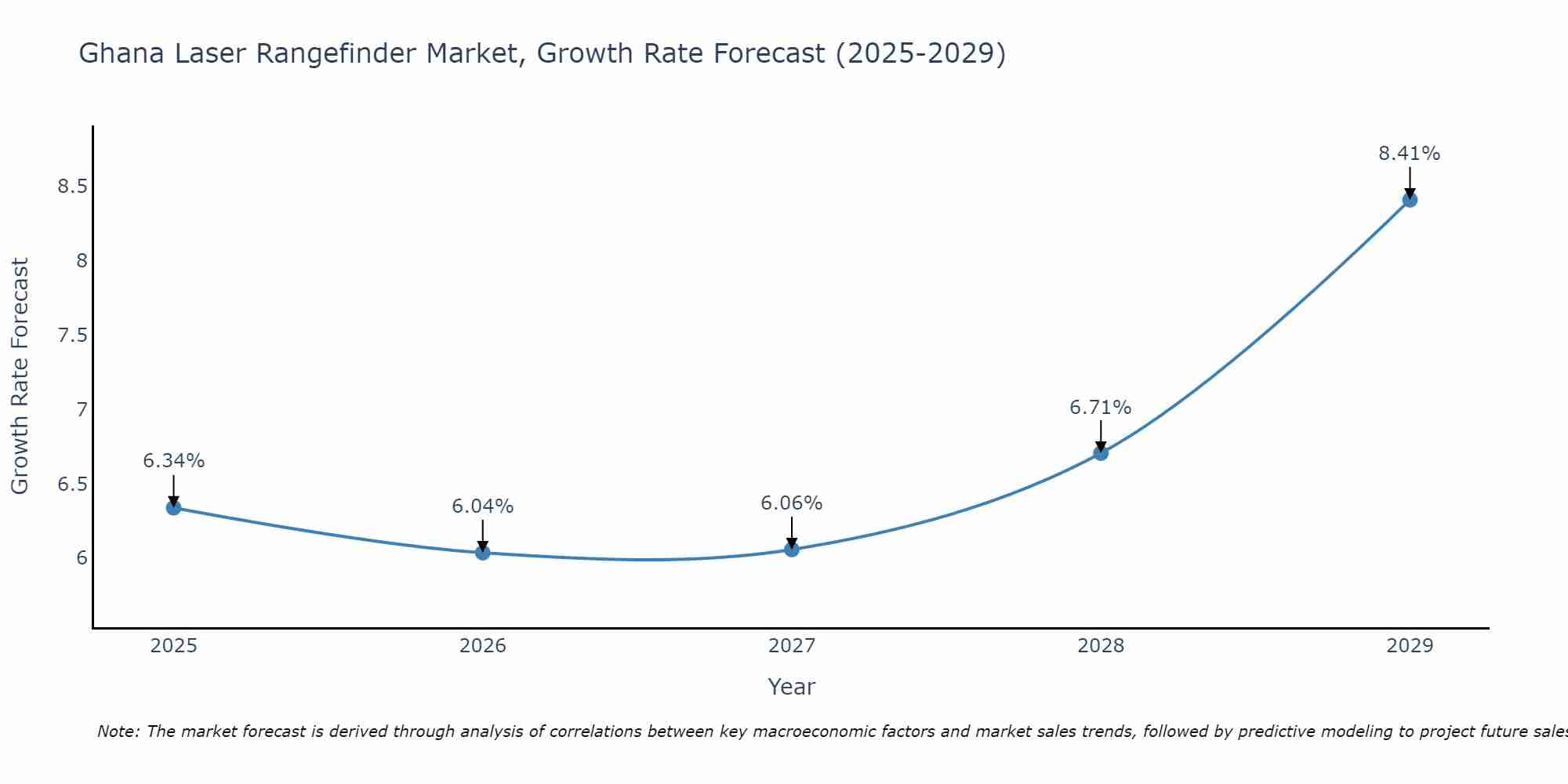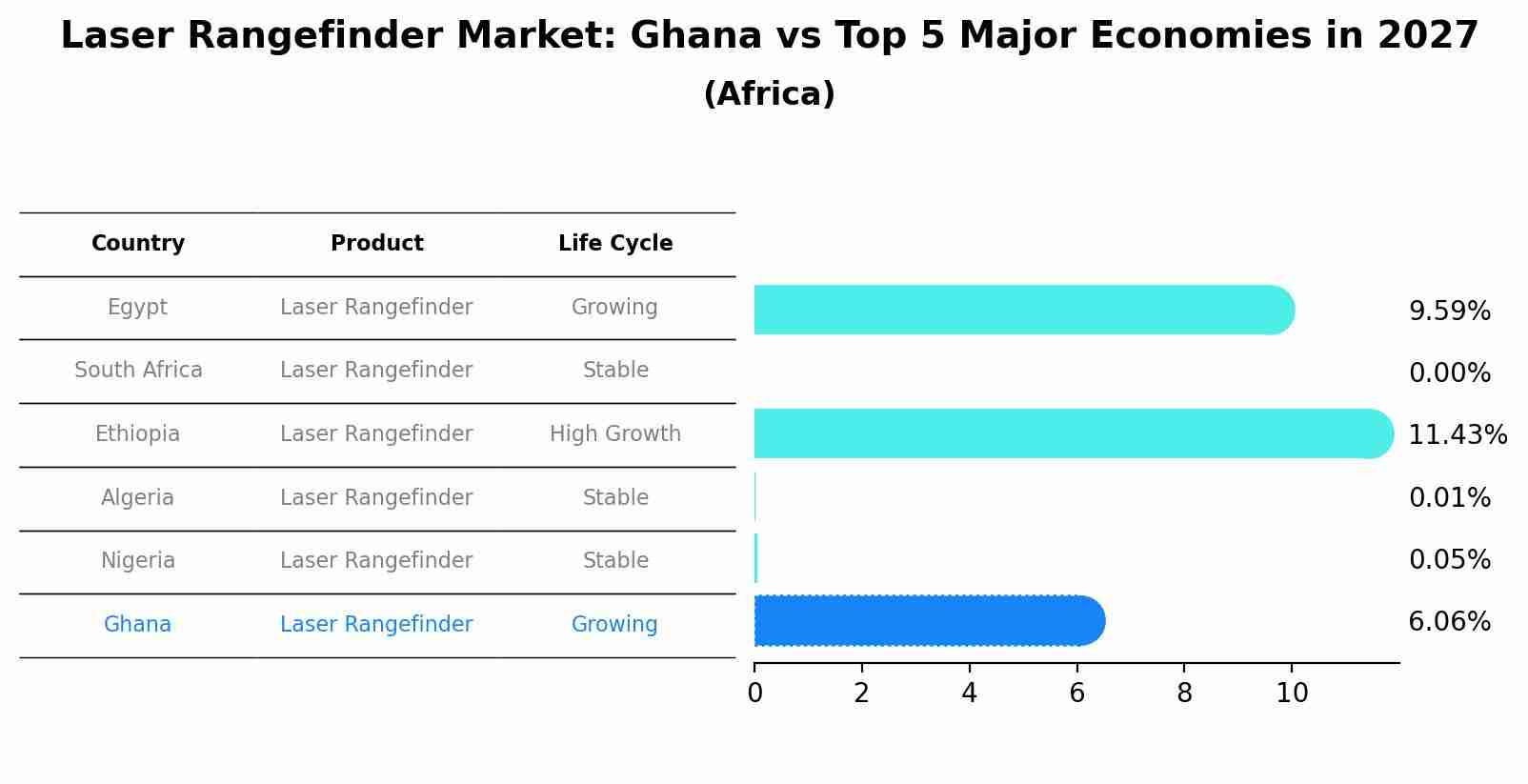Ghana Laser Rangefinder Market (2025-2031) Outlook | Forecast, Analysis, Value, Companies, Growth, Share, Size, Revenue, Trends & Industry
| Product Code: ETC365996 | Publication Date: Aug 2022 | Updated Date: Aug 2025 | Product Type: Market Research Report | |
| Publisher: 6Wresearch | Author: Shubham Padhi | No. of Pages: 75 | No. of Figures: 35 | No. of Tables: 20 |
Ghana Laser Rangefinder Market Size Growth Rate
The Ghana Laser Rangefinder Market is projected to witness mixed growth rate patterns during 2025 to 2029. Commencing at 6.34% in 2025, growth builds up to 8.41% by 2029.

Laser Rangefinder Market: Ghana vs Top 5 Major Economies in 2027 (Africa)
In the Africa region, the Laser Rangefinder market in Ghana is projected to expand at a growing growth rate of 6.06% by 2027. The largest economy is Egypt, followed by South Africa, Ethiopia, Algeria and Nigeria.

Ghana Laser Rangefinder Market Overview
In Ghana, the laser rangefinder market is witnessing steady growth, driven by the increasing demand for accurate distance measurement solutions in military, hunting, surveying, and outdoor recreational activities. Laser rangefinders, utilizing laser pulses to determine the distance between the device and a target object, offer advantages such as speed, precision, and long-range capability, making them essential tools for target acquisition, navigation, and mapping tasks. With Ghana growing defense and security needs, as well as outdoor sports and adventure tourism, the market for laser rangefinders is expected to remain robust in the country.
Drivers of the market
The Ghana laser rangefinder market is witnessing growth due to increasing demand from military, law enforcement, surveying, and outdoor sports applications. Laser rangefinders` capabilities in accurately measuring distance and targeting objects are driving their adoption in the country.
Challenges of the market
One of the main challenges for the laser rangefinder market in Ghana is the limited demand for precision measurement devices. Educating consumers about the applications of laser rangefinders in surveying and outdoor recreation is essential for market growth.
Government Policy of the market
The Ghana government acknowledges the importance of laser rangefinders in various applications such as military targeting, surveying, forestry, and sports. To support the laser rangefinder market, the government may implement policies to promote the production, distribution, and use of laser rangefinder products. This could include providing incentives for rangefinder manufacturers, implementing standards and regulations for rangefinder accuracy and safety, and supporting research and development initiatives to improve rangefinder performance and functionality. Additionally, the government may collaborate with industry stakeholders to address challenges such as technology cost, accessibility, and interoperability in the laser rangefinder market.
Key Highlights of the Report:
- Ghana Laser Rangefinder Market Outlook
- Market Size of Ghana Laser Rangefinder Market, 2024
- Forecast of Ghana Laser Rangefinder Market, 2031
- Historical Data and Forecast of Ghana Laser Rangefinder Revenues & Volume for the Period 2021-2031
- Ghana Laser Rangefinder Market Trend Evolution
- Ghana Laser Rangefinder Market Drivers and Challenges
- Ghana Laser Rangefinder Price Trends
- Ghana Laser Rangefinder Porter's Five Forces
- Ghana Laser Rangefinder Industry Life Cycle
- Historical Data and Forecast of Ghana Laser Rangefinder Market Revenues & Volume By Type for the Period 2021-2031
- Historical Data and Forecast of Ghana Laser Rangefinder Market Revenues & Volume By Telescope Later Rangefinder for the Period 2021-2031
- Historical Data and Forecast of Ghana Laser Rangefinder Market Revenues & Volume By Hand-held Later Rangefinder for the Period 2021-2031
- Historical Data and Forecast of Ghana Laser Rangefinder Market Revenues & Volume By Application for the Period 2021-2031
- Historical Data and Forecast of Ghana Laser Rangefinder Market Revenues & Volume By Military for the Period 2021-2031
- Historical Data and Forecast of Ghana Laser Rangefinder Market Revenues & Volume By Construction for the Period 2021-2031
- Historical Data and Forecast of Ghana Laser Rangefinder Market Revenues & Volume By Industrial for the Period 2021-2031
- Historical Data and Forecast of Ghana Laser Rangefinder Market Revenues & Volume By Sports for the Period 2021-2031
- Historical Data and Forecast of Ghana Laser Rangefinder Market Revenues & Volume By Forestry for the Period 2021-2031
- Historical Data and Forecast of Ghana Laser Rangefinder Market Revenues & Volume By Others for the Period 2021-2031
- Ghana Laser Rangefinder Import Export Trade Statistics
- Market Opportunity Assessment By Type
- Market Opportunity Assessment By Application
- Ghana Laser Rangefinder Top Companies Market Share
- Ghana Laser Rangefinder Competitive Benchmarking By Technical and Operational Parameters
- Ghana Laser Rangefinder Company Profiles
- Ghana Laser Rangefinder Key Strategic Recommendations
Frequently Asked Questions About the Market Study (FAQs):
- Single User License$ 1,995
- Department License$ 2,400
- Site License$ 3,120
- Global License$ 3,795
Search
Related Reports
- ASEAN Bearings Market (2025-2031) | Strategy, Consumer Insights, Analysis, Investment Trends, Opportunities, Growth, Size, Share, Industry, Revenue, Segments, Value, Segmentation, Supply, Forecast, Restraints, Outlook, Competition, Drivers, Trends, Demand, Pricing Analysis, Competitive, Strategic Insights, Companies, Challenges
- Europe Flooring Market (2025-2031) | Outlook, Share, Industry, Trends, Forecast, Companies, Revenue, Size, Analysis, Growth & Value
- Saudi Arabia Manlift Market (2025-2031) | Outlook, Size, Growth, Trends, Companies, Industry, Revenue, Value, Share, Forecast & Analysis
- Uganda Excavator, Crane, and Wheel Loaders Market (2025-2031) | Strategy, Consumer Insights, Analysis, Investment Trends, Opportunities, Growth, Size, Share, Industry, Revenue, Segments, Value, Segmentation, Supply, Forecast, Restraints, Outlook, Competition, Drivers, Trends, Demand, Pricing Analysis, Competitive, Strategic Insights, Companies, Challenges
- Rwanda Excavator, Crane, and Wheel Loaders Market (2025-2031) | Strategy, Consumer Insights, Analysis, Investment Trends, Opportunities, Growth, Size, Share, Industry, Revenue, Segments, Value, Segmentation, Supply, Forecast, Restraints, Outlook, Competition, Drivers, Trends, Demand, Pricing Analysis, Competitive, Strategic Insights, Companies, Challenges
- Kenya Excavator, Crane, and Wheel Loaders Market (2025-2031) | Strategy, Consumer Insights, Analysis, Investment Trends, Opportunities, Growth, Size, Share, Industry, Revenue, Segments, Value, Segmentation, Supply, Forecast, Restraints, Outlook, Competition, Drivers, Trends, Demand, Pricing Analysis, Competitive, Strategic Insights, Companies, Challenges
- Angola Excavator, Crane, and Wheel Loaders Market (2025-2031) | Strategy, Consumer Insights, Analysis, Investment Trends, Opportunities, Growth, Size, Share, Industry, Revenue, Segments, Value, Segmentation, Supply, Forecast, Restraints, Outlook, Competition, Drivers, Trends, Demand, Pricing Analysis, Competitive, Strategic Insights, Companies, Challenges
- Israel Intelligent Transport System Market (2025-2031) | Strategy, Consumer Insights, Analysis, Investment Trends, Opportunities, Growth, Size, Share, Industry, Revenue, Segments, Value, Segmentation, Supply, Forecast, Restraints, Outlook, Competition, Drivers, Trends, Demand, Pricing Analysis, Competitive, Strategic Insights, Companies, Challenges
- Uganda Precast and Aggregate Market (2025-2031) | Strategy, Consumer Insights, Analysis, Investment Trends, Opportunities, Growth, Size, Share, Industry, Revenue, Segments, Value, Segmentation, Supply, Forecast, Restraints, Outlook, Competition, Drivers, Trends, Demand, Pricing Analysis, Competitive, Strategic Insights, Companies, Challenges
- Australia IT Asset Disposal Market (2025-2031) | Strategy, Consumer Insights, Analysis, Investment Trends, Opportunities, Growth, Size, Share, Industry, Revenue, Segments, Value, Segmentation, Supply, Forecast, Restraints, Outlook, Competition, Drivers, Trends, Demand, Pricing Analysis, Competitive, Strategic Insights, Companies, Challenges
Industry Events and Analyst Meet
Our Clients
Whitepaper
- Middle East & Africa Commercial Security Market Click here to view more.
- Middle East & Africa Fire Safety Systems & Equipment Market Click here to view more.
- GCC Drone Market Click here to view more.
- Middle East Lighting Fixture Market Click here to view more.
- GCC Physical & Perimeter Security Market Click here to view more.
6WResearch In News
- Doha a strategic location for EV manufacturing hub: IPA Qatar
- Demand for luxury TVs surging in the GCC, says Samsung
- Empowering Growth: The Thriving Journey of Bangladesh’s Cable Industry
- Demand for luxury TVs surging in the GCC, says Samsung
- Video call with a traditional healer? Once unthinkable, it’s now common in South Africa
- Intelligent Buildings To Smooth GCC’s Path To Net Zero













